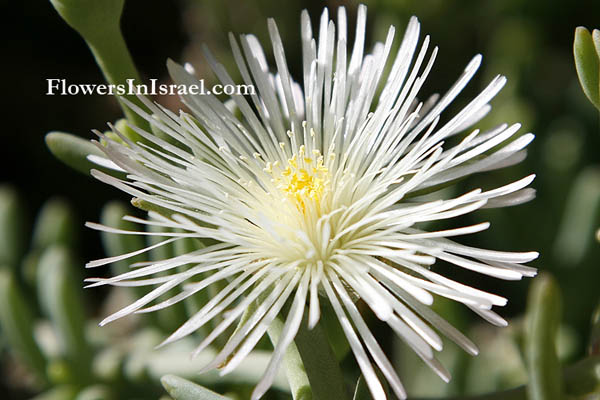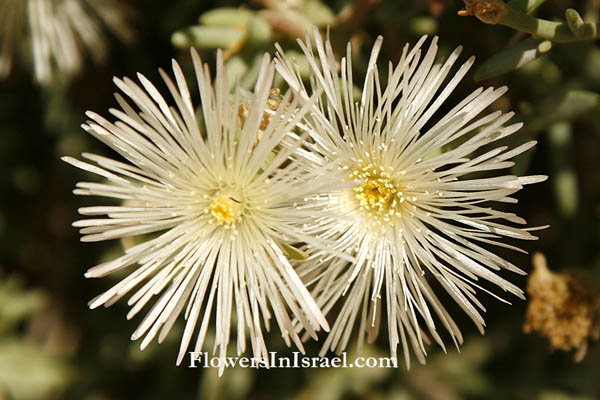Egyptian Fig-marigold, Slender-Leaved Ice Plant,
Hebrew: אהל מצוי, Arabic: حر, سمح, غاسول
| Scientific name: | Mesembryanthemum nodiflorum L. | |
| Common name: | Egyptian Fig-marigold, Slender-Leaved Ice Plant | |
| Hebrew name: | אהל מצוי | |
| Arabic name: | حر, سمح, غاسول,"hurr, samH, ghasool" | |
| Plant Family: | Aizoaceae, חיעדיים |

|
| Life form: | Annual | |
| Succulence: | Stem + leaf succulent | |
| Stems: | Prostrate to ascending, branched from base, 15-20 cm, sessile | |
| Leaves: | Opposite, terete, smooth and cylindrical | |
| Inflorescence: | Cyme or flower axillary; pedicel short | |
| Flowers: | 4-5 mm in diameter, 20 cream white petals; 10 stamens | |
| Fruits / pods: | Capsules finely papillate; seeds, smooth to minutely tuberculate | |
| Flowering Period: | February, March, April, May, June | |
| Habitat: | Salty habitats, Nutrient-rich soils, ruderal | |
| Distribution: | Mediterranean Woodlands and Shrublands, Semi-steppe shrublands, Shrub-steppes, Deserts and extreme deserts | |
| Chorotype: | Euro-Siberian - Med - Saharo-Arabian | |
| Summer shedding: | Ephemeral |

Derivation of the botanical name: Mesembryanthemum , mesembrianthemum, Greek, mesembria, "midday"; anthemon, "flower"; in allusion to the fact that the only species then known all bloomed at noon. When species of other habits became known, the genus was renamed mesembryanthemum. As now spelled, the derivation is mesos, "middle"; embryon, "fruit"; anthemon, "flower." nodiflorum, nodus, "a knot"; florus, "to bloom, to flower"; flowers from nodes. The Hebrew name:אהל, ohol, of uncertain origin. Perhaps borrowed from agaruh, aguruh (=aloewood), which are probably Greek aloe (= aloe), is probably a Hebrew loan word.
|